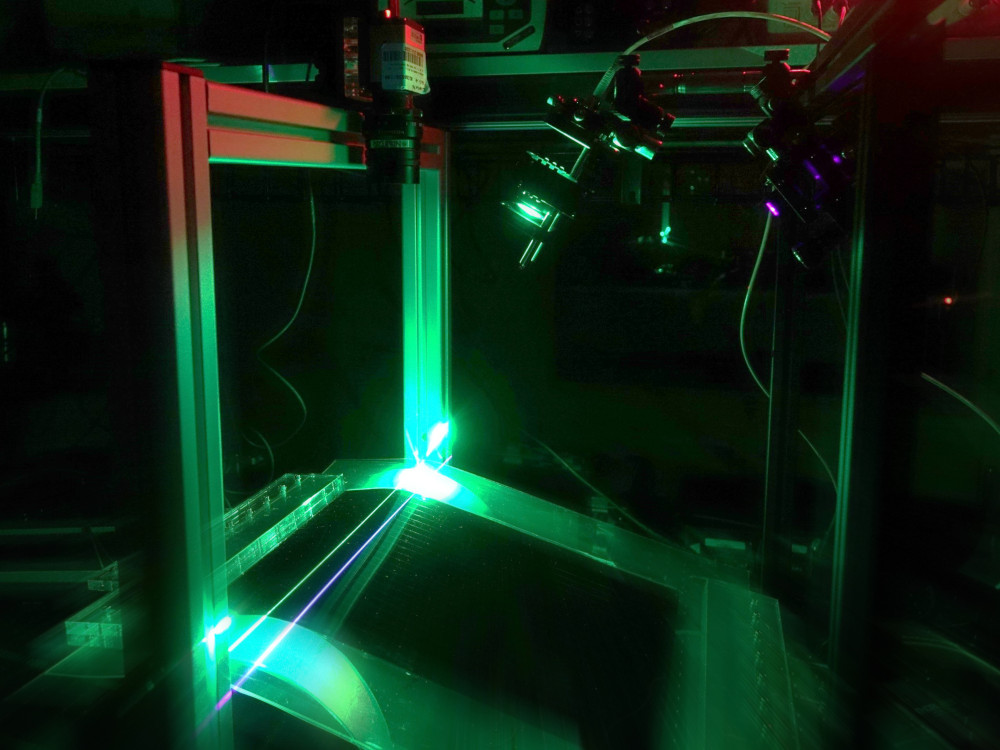
12 Jun AI-supported and modular: optical metrology in production
Faster, more accurate, more flexible – optimization in production is essential. Researchers at the Fraunhofer Institute for Material and Beam Technology IWS have developed a solution that uses optical measurement technology and artificial intelligence to detect, classify and visualize defects in real time and report them to the production plant.
The system developed by the researchers, called SURFinpro, detects surface defects, artifacts and texture changes and evaluates them with the support of artificial intelligence. The method is capable of quickly recording surfaces in three dimensions at high resolution and generating further information from this measurement data in-line with ongoing production. “Defects are not only detected as such,” explains Dr. Christopher Taudt, group leader surface metrology at the Fraunhofer Application Center for Optical Metrology and Surface Technologies (AZOM) of the Fraunhofer IWS in Zwickau. “The system classifies them at the same time and thus directly creates a further context. Our customers receive information about the type of defect and numerous other parameters such as the defect density, the geometric dimensions of the defect or the defect frequency. This represents a significant added value compared to conventional systems.”
Optimization during ongoing production
According to the institute, the measuring system has been successfully in use for more than a year and analyzes a roll-to-roll process on a width of 70 centimeters. To leverage further optimization potential, Taudt and his team are training SURFinpro during ongoing production. The scientists are working with a catalog of defects. With the reported errors, they feed a neural network and thus make the detection of anomalies more precise. The researchers use the measurement information to check, for example, whether the defects are new or whether they are changing. The system must respond dynamically accordingly. “On the one hand, we are working on developing better neural networks that get by with less data,” explains the scientist, “in addition, we are developing new training strategies on the fly.”
New fields of application
The technology is said to be currently being optimized for additional fields of application, such as continuous manufacturing processes for fiber composites. “In this field, our partners are not only concerned with avoiding defects close to the surface – it is also about multidimensional detection and the assessment of components,” clarifies Taudt. Another target group that will have access to the algorithms and the system for defect classification is the semiconductor industry, for example for the production of flexible semiconductor material.
Currently, the Fraunhofer AZOM solution uses a maximum of four cameras. In a further step, the researchers would now like to supplement it with additional camera systems. This is of interest regardless of the process – whether for fiber composites with very large components or for classic roll-to-roll processes, such as in the photovoltaics industry.
Less data for the same information content
Another starting point for the scientists is the speed of the solution. Particularly with regard to fiber-reinforced plastics, but also in textile processing, especially high cycle times are required. “Increasing speed is an important issue in this context, and we have the know-how to meet these requirements,” explains Taudt. “In our solution, we use machine learning and artificial intelligence techniques, on the one hand for evaluation, but also to accelerate evaluation steps. A corresponding measurement evaluation consists of a manageable number of individual steps in which data is filtered and reduced. Here we are continuously developing new technologies to become even faster and, for example, to be able to extract the same information content from less data.”
Central aspect: modularity
According to Taudt, a central aspect of the solution is also its modularity: thanks to a sophisticated modular principle with efficiency-tested components, the system SURFinpro can be widely used and easily adapted: “A large number of the technologies we use in our system were developed as individual building blocks in such a way that they can also be effectively introduced in various other contexts and projects.” The Fraunhofer AZOM researchers’ project is a prime example of the success and practicality of this modular approach, the scientist emphasizes.
Source and image: www.iws.fraunhofer.de






